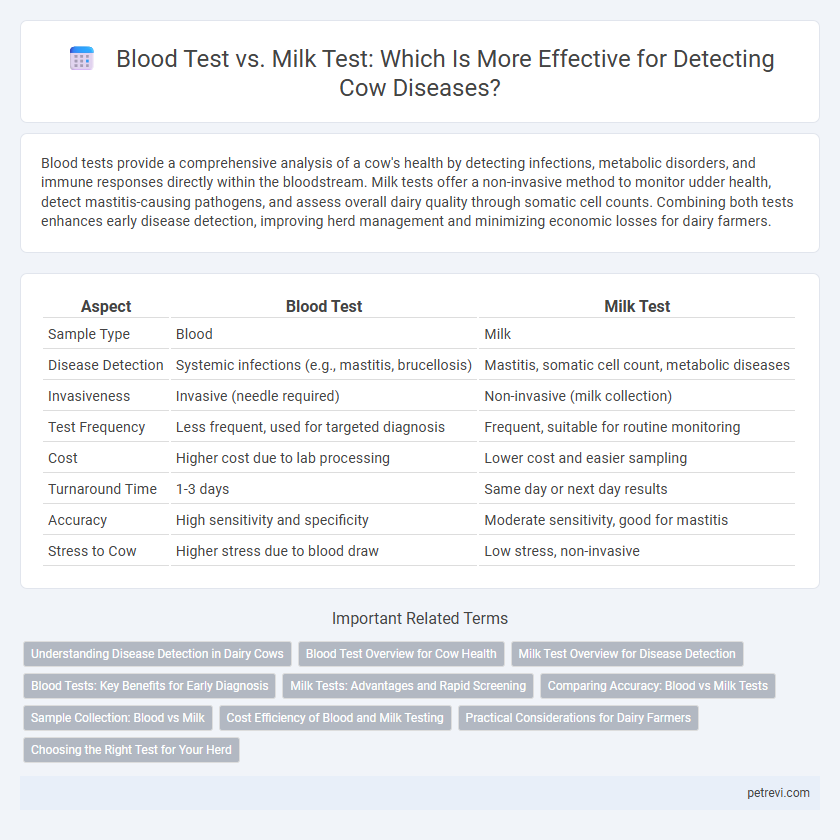Blood tests provide a comprehensive analysis of a cow's health by detecting infections, metabolic disorders, and immune responses directly within the bloodstream. Milk tests offer a non-invasive method to monitor udder health, detect mastitis-causing pathogens, and assess overall dairy quality through somatic cell counts. Combining both tests enhances early disease detection, improving herd management and minimizing economic losses for dairy farmers.
Table of Comparison
| Aspect | Blood Test | Milk Test |
|---|---|---|
| Sample Type | Blood | Milk |
| Disease Detection | Systemic infections (e.g., mastitis, brucellosis) | Mastitis, somatic cell count, metabolic diseases |
| Invasiveness | Invasive (needle required) | Non-invasive (milk collection) |
| Test Frequency | Less frequent, used for targeted diagnosis | Frequent, suitable for routine monitoring |
| Cost | Higher cost due to lab processing | Lower cost and easier sampling |
| Turnaround Time | 1-3 days | Same day or next day results |
| Accuracy | High sensitivity and specificity | Moderate sensitivity, good for mastitis |
| Stress to Cow | Higher stress due to blood draw | Low stress, non-invasive |
Understanding Disease Detection in Dairy Cows
Blood tests in dairy cows provide detailed insights into systemic infections and immune responses by analyzing biomarkers such as white blood cell counts and specific antibodies, enabling early detection of diseases like mastitis or brucellosis. Milk tests target somatic cell counts and pathogen presence directly in the udder, offering a practical and non-invasive method to monitor udder health and identify subclinical mastitis. Combining both blood and milk tests enhances the accuracy of disease detection, improving herd health management and milk quality in dairy production.
Blood Test Overview for Cow Health
Blood tests for cows provide a precise evaluation of overall health by detecting infections, metabolic disorders, and immune responses early. These tests analyze components such as white blood cell counts, enzymes, and antibodies, offering comprehensive insight into the cow's physiological condition. Compared to milk tests, blood tests can identify systemic diseases before clinical symptoms appear, enabling timely intervention and better herd management.
Milk Test Overview for Disease Detection
Milk testing offers a non-invasive and efficient method for detecting cow diseases such as mastitis, bovine leukemia virus, and subclinical infections by analyzing somatic cell counts, pathogens, and biochemical markers. This approach enables early diagnosis and continuous health monitoring without the stress associated with blood sampling. Utilizing technologies like PCR and ELISA on milk samples enhances disease detection accuracy, promoting better herd management and milk quality assurance.
Blood Tests: Key Benefits for Early Diagnosis
Blood tests provide a precise and early detection method for cow diseases by identifying pathogens and immune responses before clinical symptoms appear. These tests enable timely intervention, improving cow health management and reducing the spread of infectious diseases within herds. Early diagnosis through blood testing enhances treatment outcomes and supports effective herd productivity monitoring.
Milk Tests: Advantages and Rapid Screening
Milk tests for cow disease detection offer a non-invasive, cost-effective method that allows frequent sampling without stressing the animals, enhancing herd health monitoring. They provide rapid screening capabilities for common infections like mastitis by detecting somatic cell counts, pathogens, and antibiotic residues directly in milk. This method supports early disease intervention, improves milk quality, and reduces dependence on blood tests that require specialized handling and cause animal discomfort.
Comparing Accuracy: Blood vs Milk Tests
Blood tests for cow disease detection offer higher accuracy in identifying systemic infections by directly analyzing biomarkers in the bloodstream, while milk tests provide a non-invasive alternative that detects localized mammary gland infections and metabolic disorders. Studies indicate blood diagnostics yield more reliable results for early-stage diseases such as bovine tuberculosis and brucellosis, whereas milk tests excel in monitoring mastitis through somatic cell counts and pathogen presence. Choosing between blood and milk tests depends on the targeted disease, with blood tests favored for comprehensive diagnostics and milk tests preferred for routine herd health monitoring.
Sample Collection: Blood vs Milk
Sample collection for cow disease detection differs significantly between blood and milk tests, with blood samples requiring venipuncture from the jugular vein, ensuring accurate systemic infection diagnosis. Milk sample collection is non-invasive, obtained during regular milking sessions, making it ideal for monitoring udder health and mastitis detection. Blood tests offer precise identification of systemic diseases, while milk tests provide localized insights into mammary gland infections.
Cost Efficiency of Blood and Milk Testing
Milk testing offers a cost-efficient alternative to blood testing for cow disease detection, as it requires less labor and reduces the need for invasive procedures. Blood tests, while highly accurate, typically incur higher costs due to veterinary involvement and sample processing. Routine milk testing enables early disease detection at a lower operational expense, making it advantageous for large-scale dairy operations.
Practical Considerations for Dairy Farmers
Blood tests provide immediate and accurate diagnosis of systemic infections in cows, essential for early treatment and preventing disease spread in dairy herds. Milk tests offer a non-invasive, cost-effective option ideal for routine screening of mastitis and metabolic disorders, enabling timely management of milk quality. Dairy farmers must balance testing frequency, expense, and the specific diseases targeted to optimize herd health and maintain productivity.
Choosing the Right Test for Your Herd
Selecting the appropriate test for cow disease detection depends on the specific conditions of your herd and the diseases prevalent in your region. Blood tests provide accurate detection of systemic infections and early-stage diseases, offering comprehensive insights into the animal's health status. Milk tests are cost-effective for monitoring lactating cows, identifying mastitis and udder infections, and allowing for rapid, non-invasive screening during routine milking.
Blood Test vs Milk Test for Cow Disease Detection Infographic

 petrevi.com
petrevi.com